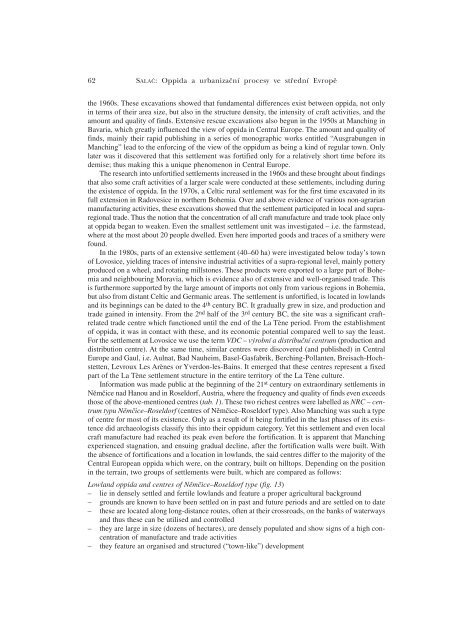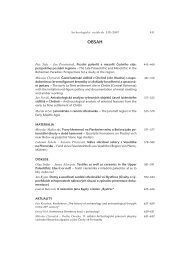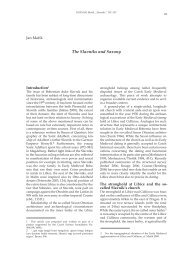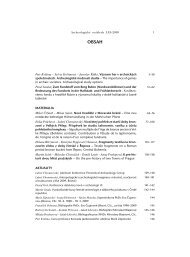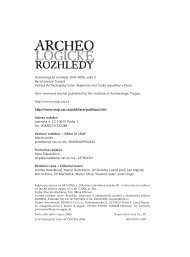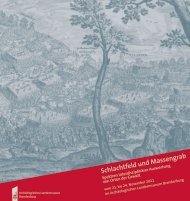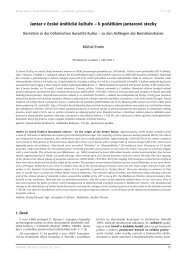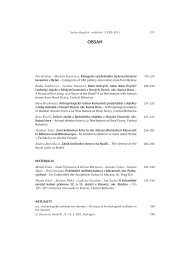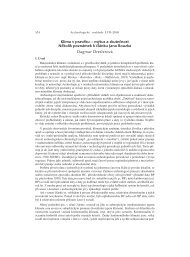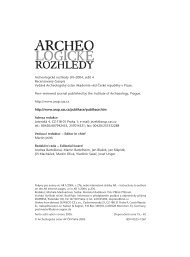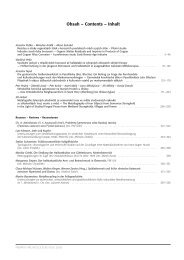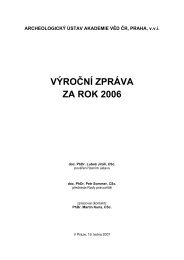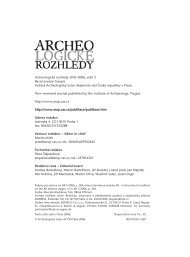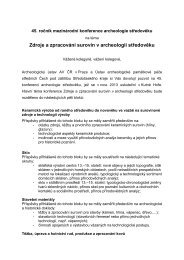Archeologické rozhledy 2011 - Archeologický ústav AV ČR
Archeologické rozhledy 2011 - Archeologický ústav AV ČR
Archeologické rozhledy 2011 - Archeologický ústav AV ČR
- No tags were found...
You also want an ePaper? Increase the reach of your titles
YUMPU automatically turns print PDFs into web optimized ePapers that Google loves.
62SALAâ: Oppida a urbanizaãní procesy ve stfiední Evropûthe 1960s. These excavations showed that fundamental differences exist between oppida, not onlyin terms of their area size, but also in the structure density, the intensity of craft activities, and theamount and quality of finds. Extensive rescue excavations also begun in the 1950s at Manching inBavaria, which greatly influenced the view of oppida in Central Europe. The amount and quality offinds, mainly their rapid publishing in a series of monographic works entitled “Ausgrabungen inManching” lead to the enforcing of the view of the oppidum as being a kind of regular town. Onlylater was it discovered that this settlement was fortified only for a relatively short time before itsdemise; thus making this a unique phenomenon in Central Europe.The research into unfortified settlements increased in the 1960s and these brought about findingsthat also some craft activities of a larger scale were conducted at these settlements, including duringthe existence of oppida. In the 1970s, a Celtic rural settlement was for the first time excavated in itsfull extension in Radovesice in northern Bohemia. Over and above evidence of various non-agrarianmanufacturing activities, these excavations showed that the settlement participated in local and supraregionaltrade. Thus the notion that the concentration of all craft manufacture and trade took place onlyat oppida began to weaken. Even the smallest settlement unit was investigated – i.e. the farmstead,where at the most about 20 people dwelled. Even here imported goods and traces of a smithery werefound.In the 1980s, parts of an extensive settlement (40–60 ha) were investigated below today’s townof Lovosice, yielding traces of intensive industrial activities of a supra-regional level, mainly potteryproduced on a wheel, and rotating millstones. These products were exported to a large part of Bohemiaand neighbouring Moravia, which is evidence also of extensive and well-organised trade. Thisis furthermore supported by the large amount of imports not only from various regions in Bohemia,but also from distant Celtic and Germanic areas. The settlement is unfortified, is located in lowlandsand its beginnings can be dated to the 4 th century BC. It gradually grew in size, and production andtrade gained in intensity. From the 2 nd half of the 3 rd century BC, the site was a significant craftrelatedtrade centre which functioned until the end of the La Tène period. From the establishmentof oppida, it was in contact with these, and its economic potential compared well to say the least.For the settlement at Lovosice we use the term VDC – výrobní a distribuční centrum (production anddistribution centre). At the same time, similar centres were discovered (and published) in CentralEurope and Gaul, i.e. Aulnat, Bad Nauheim, Basel-Gasfabrik, Berching-Pollanten, Breisach-Hochstetten,Levroux Les Arènes or Yverdon-les-Bains. It emerged that these centres represent a fixedpart of the La Tène settlement structure in the entire territory of the La Tène culture.Information was made public at the beginning of the 21 st century on extraordinary settlements inNěmčice nad Hanou and in Roseldorf, Austria, where the frequency and quality of finds even exceedsthose of the above-mentioned centres (tab. 1). These two richest centres were labelled as NRC – centrumtypu Němčice–Roseldorf (centres of Němčice–Roseldorf type). Also Manching was such a typeof centre for most of its existence. Only as a result of it being fortified in the last phases of its existencedid archaeologists classify this into their oppidum category. Yet this settlement and even localcraft manufacture had reached its peak even before the fortification. It is apparent that Manchingexperienced stagnation, and ensuing gradual decline, after the fortification walls were built. Withthe absence of fortifications and a location in lowlands, the said centres differ to the majority of theCentral European oppida which were, on the contrary, built on hilltops. Depending on the positionin the terrain, two groups of settlements were built, which are compared as follows:Lowland oppida and centres of Němčice–Roseldorf type (fig. 13)– lie in densely settled and fertile lowlands and feature a proper agricultural background– grounds are known to have been settled on in past and future periods and are settled on to date– these are located along long-distance routes, often at their crossroads, on the banks of waterwaysand thus these can be utilised and controlled– they are large in size (dozens of hectares), are densely populated and show signs of a high concentrationof manufacture and trade activities– they feature an organised and structured (“town-like”) development


